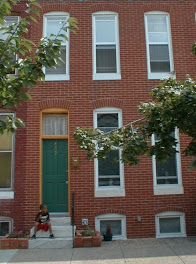By: Salina Greene, Outreach Coordinator, NHS of Baltimore
In the seemingly near-ending saga of snow storms which have plagued our area, residents in the Baltimore metropolitan area have tried to cope with almost four feet of snow. Many homeowners’ are left to wonder how to recover from the damages associated with two of the most powerful storms to hit the region in over 100 years. A number of homes are likely to end up with some form of weather-related damage. The first step to addressing some of the problems is to review your homeowner’s insurance policy. Taking a few extra steps to insure you know your level of protection can save you a lot of money in the long run.
Generally, homeowner’s policies cover burst pipes, fallen tree removals, sleet and wind damage to rooftops, trees falling on top of houses, water damage due to “ice dams” that block gutters, and other such similar cases. Food damage caused by melting snow is usually covered through a separate policy, purchasable through a federal insurance program. A good resource to look into is the National Flood Insurance Program (NFI). Many homeowners’ policies have limitations on coverage that the owner is unaware of until a significant event occurs. Most of the time, consumers opt out of certain coverage to keep their premiums down; only to discover later that certain disasters are not covered. By then, it is too late.
If your home has already sustained damage, you first need to decide whether or not it is worth filing a claim. If the damage is mild, a few hundred dollars or so, you are better off paying for it yourself. If you can afford it, file a claim only when the damage is extensive. When it comes to renewing your policy, the insurance company will look at the number of claims you have filed in the past two to three years. If you made three or more claims during this period, they may see you as high risk and not renew your policy. If your claim is substantial, it is best to file as soon as possible.
Some precautionary measures to take to protect your home after a severe snow/rain storm are as follows: Make sure all snow is shoveled away from all doors and window wells. Once the snow starts to melt, it will probably begin to seep into basements and doorways. Move any furniture and/or household items off the basement floors and near the doors to avoid being warped by water. Outdoor faucets can be protected by foam covers- the covers draw heat away from the house and keeps the faucets from freezing. Covers can be purchased at your local hardware store. If you lose power, keep your indoor faucets trickling to avoid pipe freezing. Moisture coming through the ceiling can be a sign of gutter blockage by ice. Baltimore has a ton of flat roofs. Snow and ice accumulation can cause collapse. Garages and commercial buildings are the most susceptible to this outcome. Do not attempt to clean these problems up yourself. Hire a professional or contractor to handle this for you.
Wednesday, February 17, 2010
Subscribe to:
Post Comments (Atom)




+for+blog.jpg)
.jpg)

Greetings! Unfortunately, some residents discover a danger, only sadly, when
ReplyDeletevictimized. And so I wanted to inform you of StreetZaps Baltimore. I confer with Con
Edison's Stray Voltage and Public Affairs Units and contribute to Wet Nose Guide
and New York Dog Chat. Further, our electrical collaborators anticipate more
summer than winter shockings in the years ahead.
Many thanks and I look forward to hearing from you soon.
Best,
Blair Sorrel
WHY URBAN METAL ISN'T PRECIOUS- Blair Sorrel, Founder, www.StreetZaps.com
Of course, you want a worry-free walk year-round, so adopt this simple strategy:
EYEBALL THE BLOCK, AVOID A SHOCK.
Take just a few seconds to survey the immediate surroundings and make your
trajectory toward a non-conductive surface, ie., plastic, wood, cardboard,
rather than risking any metal or electrical fixture. The lowly, free-standing
garbage bag, is you and your dog's best friend, most of the time, unless it's
snowed and salted. Then you might contemplate indoor products. Consider the
safer, hardware-free RopeNGo leash and harness to help shield against a possible
zapping and for greater peace of mind.
CONTACT VOLTAGE DOESN'T DISCRIMINATE BY GENDER.
Your pooch's sex is irrelevant. True, the most gruesome scenario is that of a
male dog electrocuted by its own urine. Our poster girl sidled a hydrant and
limped for five days.Intuit your dog's cues, if resistant to an area, choose an
alternative route. Elude potentially live work areas or carry your canine, if
necessary. Opt for indoor products such as The Pet Loo, Hammacher Schlemmer's
Indoor Restroom, or Wee-Wee Pads, if external conditions are ominous. Dog
booties can leak and make your pooch even more vulnerable.
ARE YOU PLAYING RUSSIAN ROULETTE WITH YOUR DOG?
Any of these fixtures might be dangerous, so again, choose non-conductive where
and when possible. (link to home page fixtures listed below and/or the visuals
page):
View All StreetZaps' Home Page & Safety Images
– Street & Traffic Lights can leak if damaged internally, even if the
compartment is fully closed and the light is not illuminated
– While wooden blocks anchor Scaffolding or Sidewalk Sheds, be aware that sloppy
wiring by a contractor and/or the use of lighting equipment which is NOT
WATER-PROOFED or even suitable for outdoor usage, may still shock a passerby.
– ATM Vestibules
– Decorative Lighting
– Dog Booties may increase
the risk of a shock
- Electrical Boxes
– Fire Hydrants
– Fire Police Call Boxes
– Manhole Covers
– Muni Meters
– Phone Booths
– Service Boxes
– Street Light Boxes
– Traffic Boxes
– Work Areas
After all, why chance it when there's a choice?
BETWEEN YOU, ME, AND THE LAMPPOST.
Tampered equipment can become pernicious so please map (Report Form) damaged
fixtures and known hot spots.
we have a tendency to tend to substance the kitchen appliances, pure furnishing grouping and each one that utilities that you simply poverty that you just essential.
ReplyDeletebaltimore corporate housing
Check the roof more often.
ReplyDelete